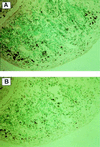Human parvovirus B19 as a causative agent for rheumatoid arthritis
- PMID: 9653169
- PMCID: PMC20958
- DOI: 10.1073/pnas.95.14.8227
Human parvovirus B19 as a causative agent for rheumatoid arthritis
Abstract
Human parvovirus B19 (B19) DNA was detected in the synovial tissues in 30 of 39 patients with rheumatoid arthritis (RA), and infrequently in those with osteoarthritis and traumatic joints. On the other hand, the expression of the B19 antigen VP-1 was specific (27/27) in RA synovium with active synovial lesions, but not in osteoarthritis and controls. The target cells of B19 were macrophages, follicular dendritic cells, T cells, and B cells, but not synovial lining cells in the synovium. B19-negative bone marrow cells, tonsil cells, and macrophage cell line U-937 cells became positive for the expression of VP-1, and more productive for interleukin 6 and tumor necrosis factor alpha when cocultured with RA synovial cells. The expression of VP-1 and the production of interleukin 6 and tumor necrosis factor alpha was significantly inhibited by the addition of neutralizing antibody for B19, suggesting that B19 detected in RA synovial cells is infective. B19 is involved in the initiation and perpetuation of RA synovitis, leading to joint lesions.
Figures





References
-
- White D G, Woolf A D, Mortimer P P, Cohen B J, Blake D R, Bacon P A. Lancet. 1985;i:419–421. - PubMed
-
- Reid D M, Reid T M S, Brown T, Rennie J A N, Eastmond C J. Lancet. 1985;i:422–425. - PubMed
-
- Woolf A D, Campion G V, Chishic K A, Wise S, Cohen B J, Klouda P T, Caul O, Dieppe P A. Arch Intern Med. 1989;149:1153–1156. - PubMed
-
- Nishioka K, Maruyama I, Sato K, Kitajima I, Nakajima Y, Osame M. Lancet. 1989;1:441. - PubMed
-
- Naides S J. Curr Opin Rheumatol. 1994;6:423–428. - PubMed
Publication types
MeSH terms
Substances
LinkOut - more resources
Full Text Sources
Other Literature Sources
Medical

